

Bipolar disorder. Bipolar disorder (also known as bipolar affective disorder, manic-depressive disorder, or manic depression) is a mental illness typically classified as a mood disorder.
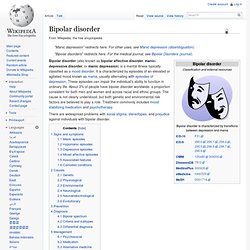
It is characterized by episodes of an elevated or agitated mood known as mania, usually alternating with episodes of depression. These episodes can impair the individual's ability to function in ordinary life. About 3% of people have bipolar disorder worldwide, a proportion consistent for both men and women and across racial and ethnic groups. The cause is not clearly understood, but both genetic and environmental risk factors are believed to play a role. Treatment commonly includes mood stabilizing medication and psychotherapy. There are widespread problems with social stigma, stereotypes, and prejudice against individuals with bipolar disorder. Attention deficit hyperactivity disorder. Attention deficit hyperactivity disorder (ADHD, similar to hyperkinetic disorder in the ICD-10) is a psychiatric disorder[1][2] of the neurodevelopmental type[3][4] in which there are significant problems of attention, hyperactivity, or acting impulsively that are not appropriate for a person's age.[5] These symptoms must begin by age six to twelve and be present for more than six months for a diagnosis to be made.[6][7] In school-aged individuals the lack of focus may result in poor school performance.
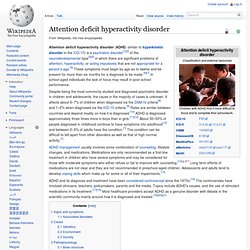
Despite being the most commonly studied and diagnosed psychiatric disorder in children and adolescents, the cause in the majority of cases is unknown. Flow (psychology) Concentrating on a task is one aspect of flow.
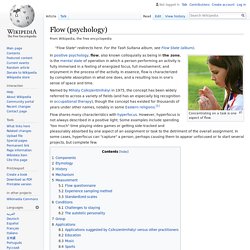
In positive psychology, flow, also known colloquially as being in the zone, is the mental state of operation in which a person performing an activity is fully immersed in a feeling of energized focus, full involvement, and enjoyment in the process of the activity. In essence, flow is characterized by complete absorption in what one does, and a resulting loss in one's sense of space and time.
Flow shares many characteristics with hyperfocus. However, hyperfocus is not always described in a positive light. Some examples include spending "too much" time playing video games or getting side-tracked and pleasurably absorbed by one aspect of an assignment or task to the detriment of the overall assignment. Just as with the conditions listed above, these conditions can be independent of one another.
Ideas similar to flow have been recognized throughout history and across cultures. Schaffer (2013) proposed 7 flow conditions: Psychosis. Psychosis (from the Greek ψυχή psyche, "mind/soul", and -ωσις -osis, "abnormal condition or derangement") refers to an abnormal condition of the mind, and is a generic psychiatric term for a mental state often described as involving a "loss of contact with reality".
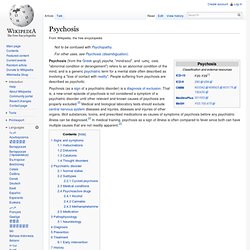
People suffering from psychosis are described as psychotic. Psychosis (as a sign of a psychiatric disorder) is a diagnosis of exclusion. Signs and symptoms[edit] People with psychosis may have one or more of the following: hallucinations, delusions, catatonia, or a thought disorder, as described below. Impairments in social cognition also occur.[3][4] Hallucinations[edit] Creativity and mental illness. Numerous studies have demonstrated correlations between creative occupations and mental illnesses, including bipolar disorder and schizophrenia.
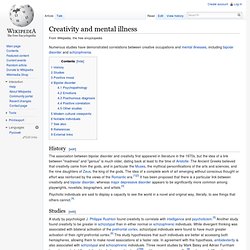
History[edit] Greco-Roman mysteries. See Western esotericism for modern "mystery religions" in the Western cultural sphere.
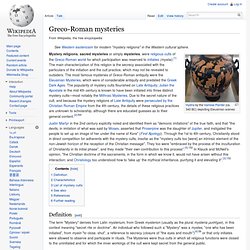
Definition[edit] The term "Mystery" derives from Latin mysterium, from Greek mysterion (usually as the plural mysteria μυστήρια), in this context meaning "secret rite or doctrine". An individual who followed such a "Mystery" was a mystes, "one who has been initiated", from myein "to close, shut", a reference to secrecy (closure of "the eyes and mouth")[4]:56 or that only initiates were allowed to observe and participate in rituals.
The Mysteries were thus cults in which all religious functions were closed to the uninitiated and for which the inner workings of the cult were kept secret from the general public. Characteristics[edit] Mystery religions form one of three types of Hellenistic religion, the others being the imperial cult or ethnic religion particular to a nation or state, and the philosophic religions such as Neoplatonism.
Mysteries thus supplement rather than compete with civil religion. 10 Ways to Become More Conscious. Previously I wrote about 14 Reasons to Become More Conscious.

Now let’s explore the how. What does it mean to become more conscious? It is the progressive realization of conscious mastery over your mind. The challenge is that it takes consciousness to grow consciousness. But you needn’t worry about this because you already have the seed. So here are 10 ways to raise your consciousness: 1. Truth raises your consciousness. First, accept the truth. Secondly, speak the truth. The more you’re able to accept and speak the truth, the more conscious you become.
Yes, there may be consequences when you switch from lies and half-truths to the full truth, but highly conscious people know that crossing that bridge is well worth the effect. 2. Courage raises your consciousness. Courage is the gatekeeper between unconscious growth and conscious growth. A powerful guiding principle to adopt is, “Whatever I fear, I must face.” 3. Compassion raises your consciousness. History of hypnosis. This article is about the development of concepts, beliefs and practices related to hypnosis and hypnotherapy from prehistoric to modern times.

Braid adopted the term hypnotism (which specifically applied to the state of the subject, rather than techniques applied by the operator) to contrast his own, unique, subject-centred, approach with those of the operator-centred mesmerists who preceded him. Early history[edit] Braid on Yoga[edit] According to his writings, Braid began to hear reports concerning the practices of various Oriental meditation techniques immediately after the publication of his major book on hypnotism, Neurypnology (1843).